or, the 18th century housewife being a kit for sewing or storage of coin and not for use in washing of windows.
The term housewife, meaning a small wallet like object, often used as a sewing kit by women, seems to have come into use sometime during the 1730's. Housewives are useful things for the 18th century reenactor, perfect for practicing your hand sewing, an excellent use for those endless scraps of fabric & ideal for keeping modern items "hidden in plain sight".
Trial records from
The Old Baily in London list numerous cases of theft and grand larceny involving "housewives" between 1730 & 1790. The first use of the term is during the robbery trial of Priscilla Scott in 1731. In addition to being put "in Fear of her Life" Mrs. Scott was also robbed of "a Snuff Box, value 10 s., a Silk Housewife, and six Shillings in Money". During the trial of Sarah Morgan in 1756 the constable from Kensington parish states he "found five shillings in silver in a housewife, put under her arm pit." In 1765, Spinster Eleanor Johnson was indited for theft thanks to "a housewife, in which there were two guineas and two half guineas". Later in 1767, thieves Elizabeth Merchant & Anne White were noted to have taken "money out of a housewife".
Robberies aren't the only period reference to housewives however. Newspaper advertisements from 1768-1770 often include housewives among other goods for sale. Catherine Rathell lists "housewives for ladies with instruments" in her advertisements in the
Virginia Gazette from October 1768 to April 1769. Ms. Rathell's monopoly on housewives is supplanted by Sarah Pitt who lists "neat pincushion housewives with looking-glasses" in her Nov. 1770's Virginia Gazette ad.
Should you be neither a thief nor in the vicinity of the Ms.s Rathell & Pitt, your next option is to make your very own housewife.
1. Draw a pattern. This will come in handy if you plan on making more than one. Mine measures approximately 4" x 11", with a pointed end. Remember to add at least 1/4" seam allowance on all sides. The pointed tip is optional, I have seen them with both square or rounded ends as well.
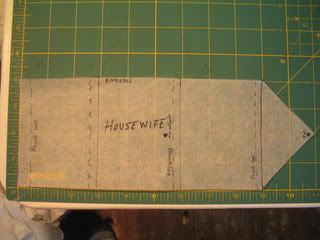
2. Divide the pattern into roughly 3 sections, or how ever many times you plan on folding the wallet. This will help when cutting pockets for the interior.
3. Cut out several layers from scrap fabric. I've chosen to use wool for the outer, a heavier linen inter lining & plain linen for the lining. You could use any combination of scrap fabrics, even being as fancy as Mrs. Scott above and make your housewife out of silk.
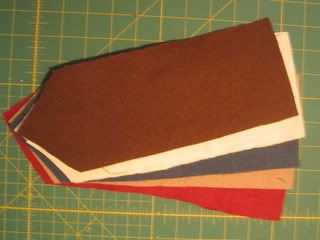
4. Cut out a selection of pockets. There is no limit to the style or number of pockets you choose. If making a housewife to hide modern items, such as a cell phone or drivers license, use those items to determine the size of your pockets. Otherwise use the divisions marked on the pattern in step 2, leaving a little space to allow the housewife to fold closed.
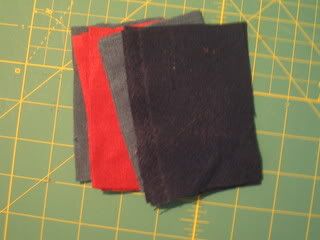
5. Hem the open ends of the pockets as needed based on the type of fabric being used.
6. Lay your pockets onto the lining. Stitch them into place, leaving 1 side open for use. Alternately, if you'd like an attached pin cushion, stitch both the top and bottom sides closed, leaving only the sides open.
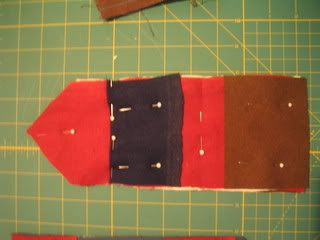
7. Lay the lining on top of the inter lining & outer. Pin the fabric sandwich together for ease of binding as desired.
8. Lay tape or a long thin strip of scrap fabric along the outer edge. Stitch in place, turning corners carefully. Make sure to catch the sides of the pockets with the binding. If adding a pin cushion, be sure to stuff the pocket before catching both sides with the binding.

9. Turn the binding around the raw edge, pinning in place as needed. Stitch in place, turning corners carefully again.

10. Attach thin tape to the outside, near the pointed end. Leave one side of the tape longer than the other for ease of wrapping & tying closed. Alternately you could attach the tape to the point itself, wrapping & tying the housewife closed with a single end, rather than two.
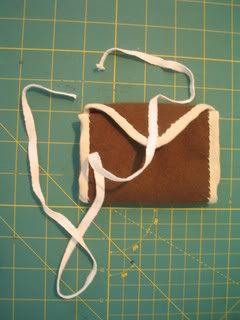
11. Stuff your housewife with all manner of things, from sewing supplies to your cell phone, id & money. Fold up, wrap the tie around & knot securely. Successfully add one more period accoutrement to your collection.
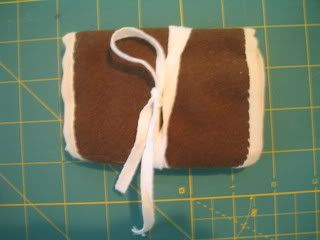
Labels: 18th Century, Accessories, Tutorials









